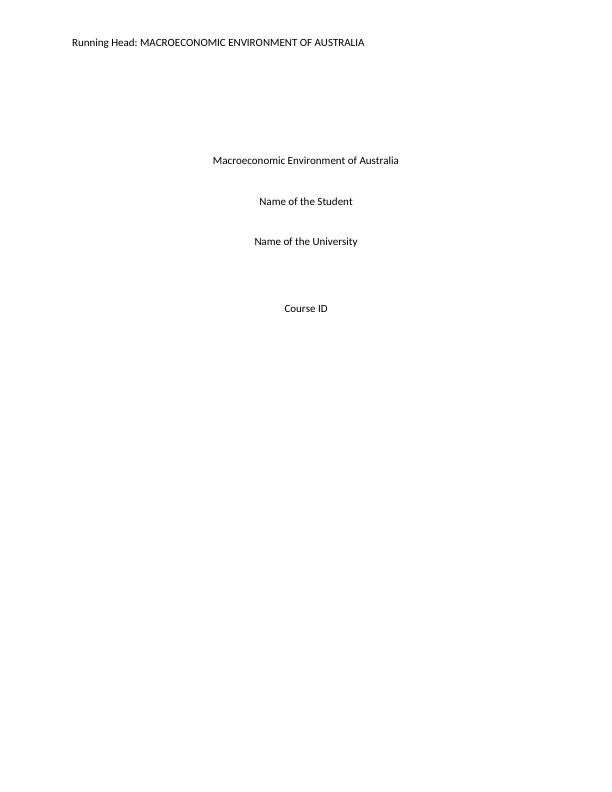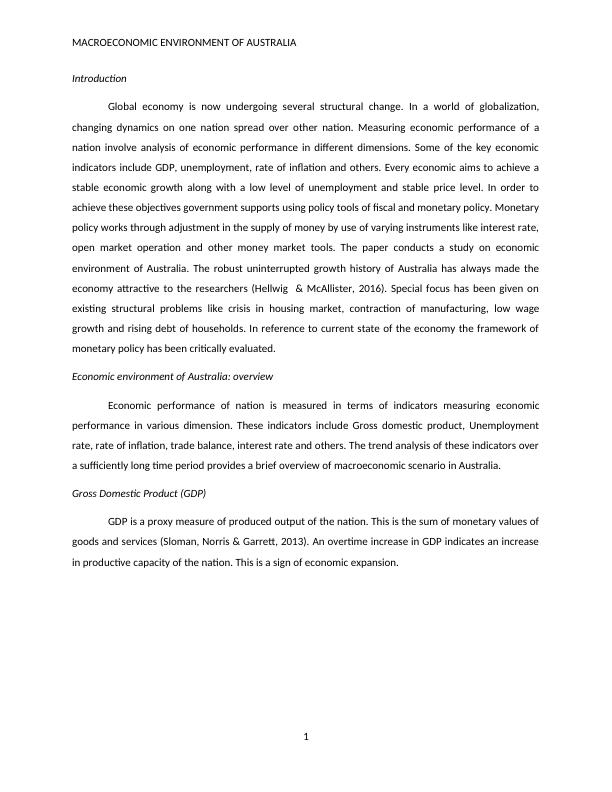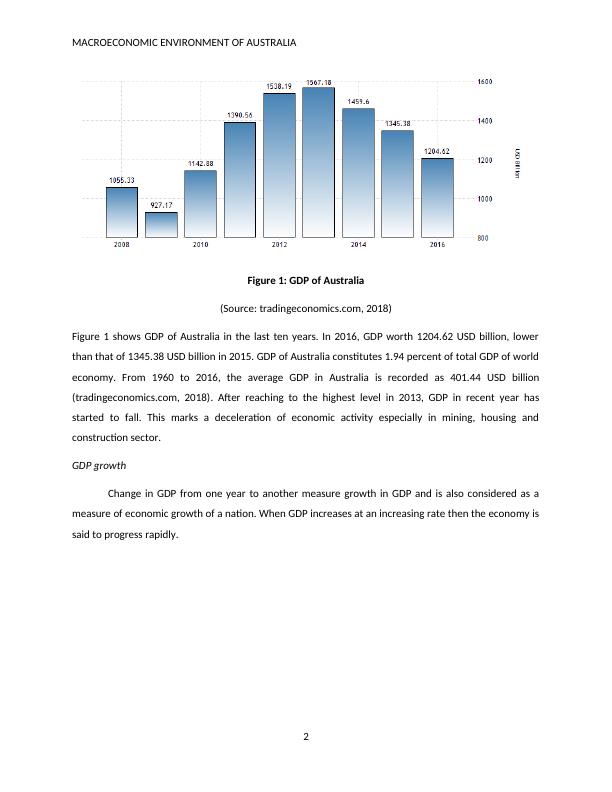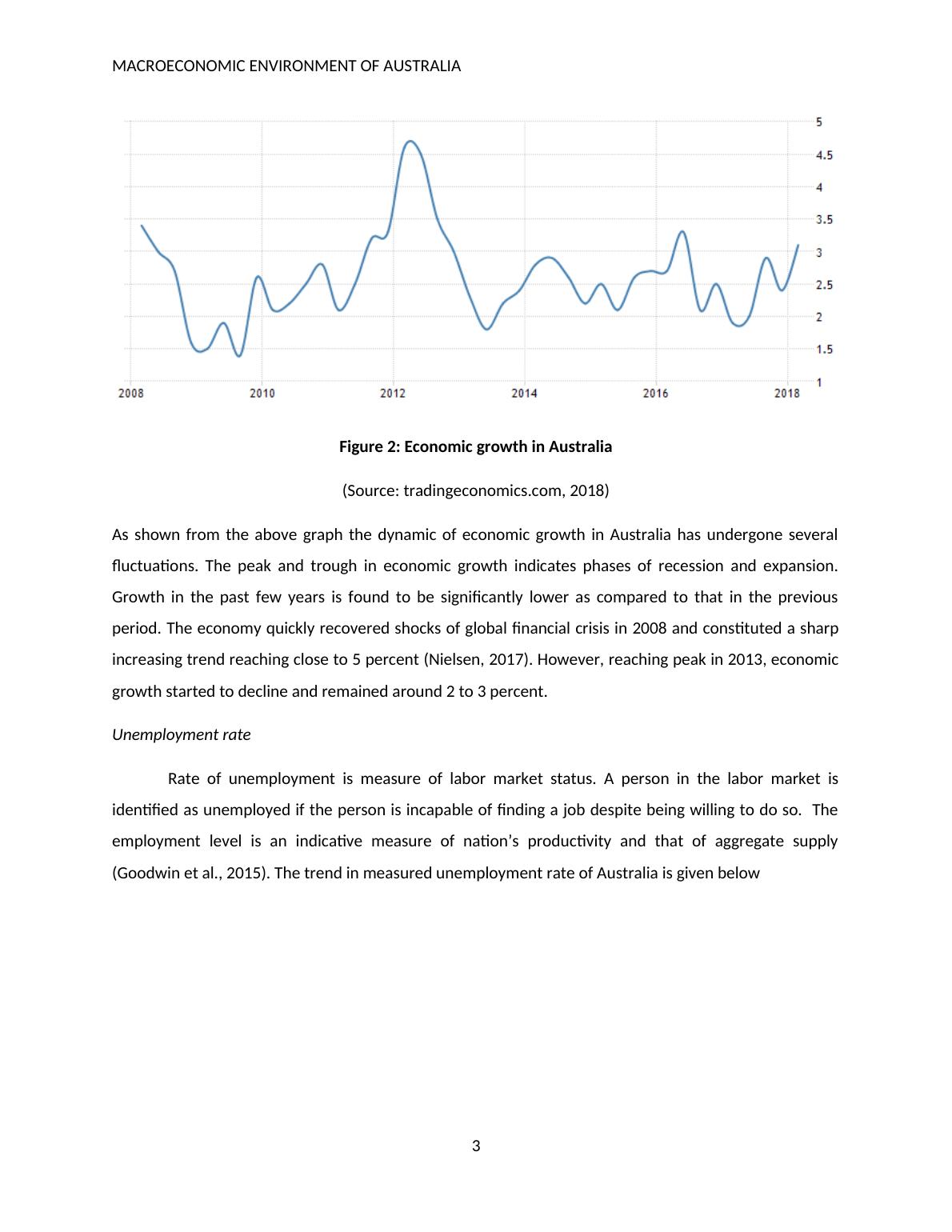Macroeconomic Environment of Australia
Added on 2021-05-31
15 Pages3489 Words45 Views
Running Head: MACROECONOMIC ENVIRONMENT OF AUSTRALIAMacroeconomic Environment of AustraliaName of the StudentName of the UniversityCourse ID

MACROECONOMIC ENVIRONMENT OF AUSTRALIAIntroduction Global economy is now undergoing several structural change. In a world of globalization,changing dynamics on one nation spread over other nation. Measuring economic performance of anation involve analysis of economic performance in different dimensions. Some of the key economicindicators include GDP, unemployment, rate of inflation and others. Every economic aims to achieve astable economic growth along with a low level of unemployment and stable price level. In order toachieve these objectives government supports using policy tools of fiscal and monetary policy. Monetarypolicy works through adjustment in the supply of money by use of varying instruments like interest rate,open market operation and other money market tools. The paper conducts a study on economicenvironment of Australia. The robust uninterrupted growth history of Australia has always made theeconomy attractive to the researchers (Hellwig & McAllister, 2016). Special focus has been given onexisting structural problems like crisis in housing market, contraction of manufacturing, low wagegrowth and rising debt of households. In reference to current state of the economy the framework ofmonetary policy has been critically evaluated. Economic environment of Australia: overviewEconomic performance of nation is measured in terms of indicators measuring economicperformance in various dimension. These indicators include Gross domestic product, Unemploymentrate, rate of inflation, trade balance, interest rate and others. The trend analysis of these indicators overa sufficiently long time period provides a brief overview of macroeconomic scenario in Australia. Gross Domestic Product (GDP)GDP is a proxy measure of produced output of the nation. This is the sum of monetary values ofgoods and services (Sloman, Norris & Garrett, 2013). An overtime increase in GDP indicates an increasein productive capacity of the nation. This is a sign of economic expansion. 1

MACROECONOMIC ENVIRONMENT OF AUSTRALIAFigure 1: GDP of Australia (Source: tradingeconomics.com, 2018)Figure 1 shows GDP of Australia in the last ten years. In 2016, GDP worth 1204.62 USD billion, lowerthan that of 1345.38 USD billion in 2015. GDP of Australia constitutes 1.94 percent of total GDP of worldeconomy. From 1960 to 2016, the average GDP in Australia is recorded as 401.44 USD billion(tradingeconomics.com, 2018). After reaching to the highest level in 2013, GDP in recent year hasstarted to fall. This marks a deceleration of economic activity especially in mining, housing andconstruction sector. GDP growth Change in GDP from one year to another measure growth in GDP and is also considered as ameasure of economic growth of a nation. When GDP increases at an increasing rate then the economy issaid to progress rapidly. 2

MACROECONOMIC ENVIRONMENT OF AUSTRALIAFigure 2: Economic growth in Australia(Source: tradingeconomics.com, 2018)As shown from the above graph the dynamic of economic growth in Australia has undergone severalfluctuations. The peak and trough in economic growth indicates phases of recession and expansion.Growth in the past few years is found to be significantly lower as compared to that in the previousperiod. The economy quickly recovered shocks of global financial crisis in 2008 and constituted a sharpincreasing trend reaching close to 5 percent (Nielsen, 2017). However, reaching peak in 2013, economicgrowth started to decline and remained around 2 to 3 percent. Unemployment rate Rate of unemployment is measure of labor market status. A person in the labor market isidentified as unemployed if the person is incapable of finding a job despite being willing to do so. Theemployment level is an indicative measure of nation’s productivity and that of aggregate supply(Goodwin et al., 2015). The trend in measured unemployment rate of Australia is given below3

End of preview
Want to access all the pages? Upload your documents or become a member.
Related Documents
Macroeconomic Environment of China and USA and its Impact on HP's Operationlg...
|13
|1661
|219
The Economy of Australia - ECCON 101 - Economicslg...
|15
|2918
|63
Economic Health of Australia Reportlg...
|8
|2701
|34
Evaluation Of Macroeconomic Performance of Australialg...
|13
|3244
|47
BUS700 Economic Assignment: Macroeconomic Performancelg...
|14
|3724
|40
Economics Assignment 2022lg...
|16
|3436
|17
